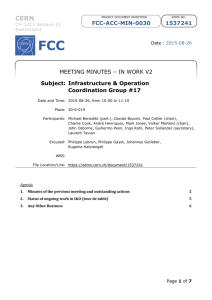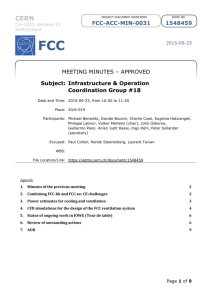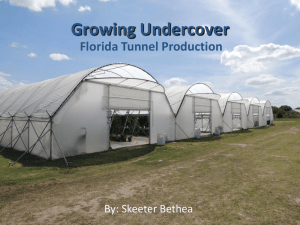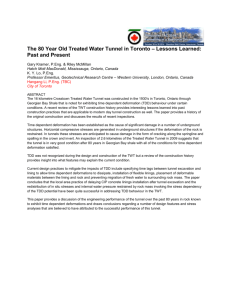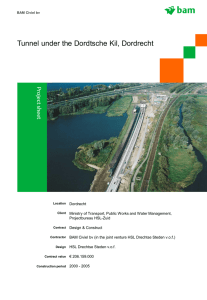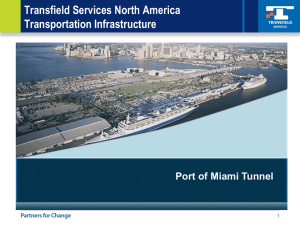FCC-1507291000 - Indico
advertisement
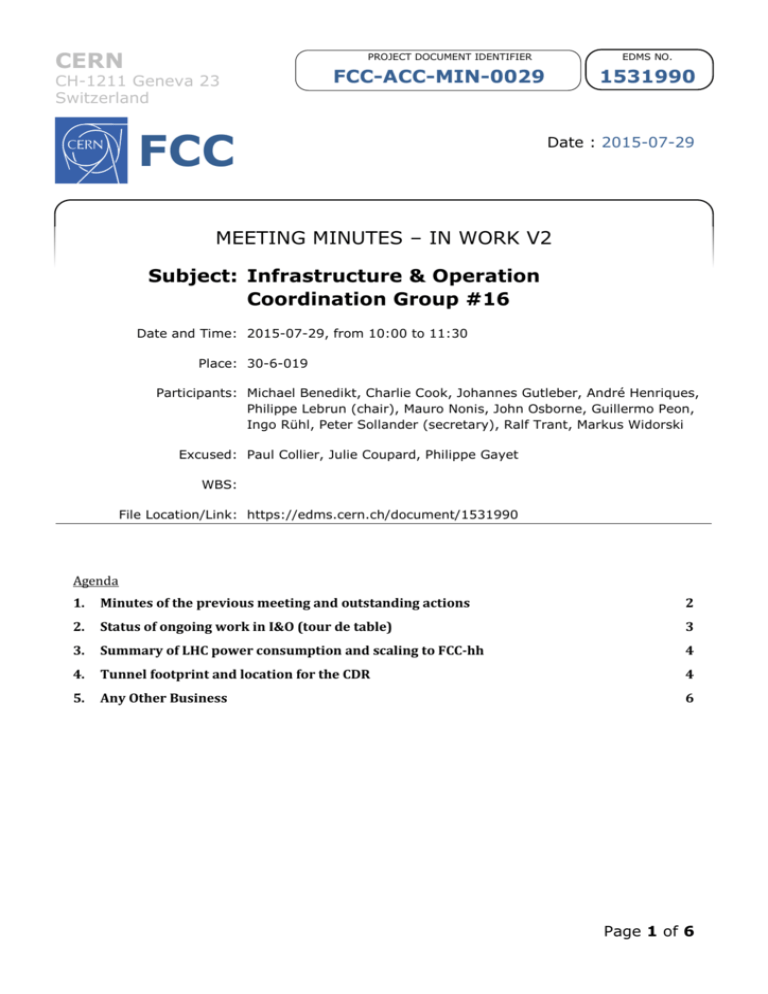
CERN
PROJECT DOCUMENT IDENTIFIER
CH-1211 Geneva 23
Switzerland
EDMS NO.
FCC-ACC-MIN-0029
FCC
1531990
Date : 2015-07-29
MEETING MINUTES – IN WORK V2
Subject: Infrastructure & Operation
Coordination Group #16
Date and Time: 2015-07-29, from 10:00 to 11:30
Place: 30-6-019
Participants: Michael Benedikt, Charlie Cook, Johannes Gutleber, André Henriques,
Philippe Lebrun (chair), Mauro Nonis, John Osborne, Guillermo Peon,
Ingo Rühl, Peter Sollander (secretary), Ralf Trant, Markus Widorski
Excused: Paul Collier, Julie Coupard, Philippe Gayet
WBS:
File Location/Link: https://edms.cern.ch/document/1531990
Agenda
1.
Minutes of the previous meeting and outstanding actions
2
2.
Status of ongoing work in I&O (tour de table)
3
3.
Summary of LHC power consumption and scaling to FCC-hh
4
4.
Tunnel footprint and location for the CDR
4
5.
Any Other Business
6
Page 1 of 6
EDMS NO.
1531990
1. Minutes of the previous meeting and outstanding actions
Philippe welcomed to the 16th meeting.
The minutes of the previous meeting were approved with a couple of minor
corrections and will be published on EDMS 1519986.
Actions are ordered by completion status, new and ongoing actions first.
Status is one of {New, Ongoing, On hold, Completed, Postponed or Cancelled}.
Description and Comments
Status
Assigned
Develop a map indicating electrical power and water cooling
needs at different locations around FCC ring
Ongoing
I&O wg
Identify limits on sector lengths coming from technical
infrastructure and accelerator systems
Mauro: no hard limits, in the worst case add booster fans.
Ongoing
I&O wg,
Accelerator
systems
Progress with study lead towards selection on single or double
tunnel option for work towards CDR
Ongoing
I&O wg
Estimate radiation doses, “cooling” times and remote-handling
needs for removal of LHC insertions towards its use as FCC
high-energy injector (See Markus’ presentation)
Ongoing
HSE
Define straight sections to detail level, which permits
documenting infrastructure requirements and constraints
Ongoing
Accelerator
design
Study ground settling in newly excavated tunnel and impact on Ongoing
machine alignment. Checking tunnel stability. John suggests
assuming it is the same as for the LEP tunnel. Survey can
provide data. Mark Jones will make a presentation at a coming
meeting. Tunnel and caverns are concerned.
M. Jones,
Accelerator
physics
Create a top-down operation model of the injector chain and
use for FCC availability studies.
Ongoing
RAMS team
Define work topics, work period and supervision line for all
personnel requests
Ongoing
Supervisors
Review practical limits on magnet mass and length
Question for transport and installation people
Not started
I&O wg
Page 2 of 6
EDMS NO.
1531990
Description and Comments
Status
Assigned
Review and validate WBS items
Ongoing
I&O wg
Elaborate and communicate work unit descriptions (identified
by 4 digits in column A of the WBS) of the Infrastructure &
Operation study: 5 lines or about 100 words with a general
description and a focus on the work foreseen.
Ongoing
I&O wg
Detail cooling and ventilation power consumption estimates
Ongoing
M. Nonis
G. Peon
2. Status of ongoing work in I&O (tour de table)
Markus presented the status of the dose rate maps as estimated at the end of
HL-LHC operation (4000 fb-1 integrated luminosity), for the investigation of
LHC as an FCC-hh high-energy injector. Dose rates maps exist for ATLAS and
parts of the LHC and will be extended. The first results indicate that the dose
rate levels should be manageable at the end of longer cooling times (several
months to one year). To judge what kind of works could be done at what time
after beam stop will depend on the detailed planning of these work tasks.
The first simulations of the simulation of ventilation pressure drop in the tunnel
have been completed; Guillermo and Mauro will have a look and a presentation
will be scheduled in the coming meeting or the following one.
Andre and Mauro are discussing ventilation and safety issues and Mauro will
present the first simulations in a coming meeting.
Peter explained that the RAMS study is on-going and that the collaboration is
extended with a doctoral student from the Delft University of Technology in the
Netherlands who help calculating failure rates and fault distributions from
cryogenics data. The RAMS team is meeting in Finland end of September.
Johannes added that the IT department is helping out with the necessary
database infrastructure and tools for the RAMS study.
The RAMS study is
currently modelling the LHC accelerator chain with the aim of validating the
method.
Page 3 of 6
EDMS NO.
1531990
John has met with people from ARUP who have been doing the geology
studies for the ILC in Japan and noted that it is very interesting to compare the
studies. The ILC study has for example placed cooling towers underground.
3. Summary of LHC power consumption and scaling to FCC-hh
Philippe presented a summary of the LHC power consumption investigations
conducted by the WG since Spring 2014, with the aim of trying to understand
discrepancies between values found in published sources and recent average
measured values.
Scaling these numbers to the FCC-hh case, , we now have a figure of
approximately 350 MW for the average power consumption, dominated by
1.9 K cryogenics..
The estimates can be used to give an initial idea of the
steady state cooling loads for the different points.
Michael added that we should start defining the distribution of equipment
around the different points on the surface and in the tunnel.
The estimates will be further refined. Guillermo will present a more detailed
view of the cooling systems at the next working group meeting.
4. Tunnel footprint and location for the CDR
Charlie presented the latest version of the tunnel footprint and location
options.
At present there are two options left; the intersecting (with the LHC) and the
non-intersecting 100 km tunnels.
The decision to keep only the 100 km options was made based on the
requirements of 100 TeV collison energy and 16 T superconducting magnets.
The non-intersecting option extends beyond the initial study boundary and
there is one portion of the tunnel for which the geological situation is very
uncertain.
The study boundary will be extended to include this portion and more data will
be collected. ARUP will add the data and update the tool.
Page 4 of 6
EDMS NO.
1531990
AMBERG will then make a comparison of the two options from an engineering
perspective (AMBERG, Civil Engineering Package 3).
John asked when the output of this work is needed and Michael answered
that he would need at least an idea about the differences between the options
by the end of November.
Mauro asked about the issue of service caverns at intermediate depth and
Philippe said that infrastructure systems should primarily be installed either at
tunnel level or close to ground level.
Intermediate level caverns could be
considered only if there are big problems with tunnel and ground level
technical equipment, e.g. excessive hydrostatic heads.
Michael asked about the geological uncertainties at the time of the LEP
construction and how the current FCC study knowledge compares.
Philippe
explained that the first LEP tunnel plans were to build a 30 km tunnel located
more under the Jura but that experts advised to reduce the overburden with a
smaller 27 km tunnel moved away from the triasic limestone in the Jura. He
added that external experts also suggested the FCC study to keep the tunnel
clear from the Jura and the pre-Alpes, which can more easily be done with the
93 km option.
John thought that the level of knowledge we have for the FCC boundary today
is less than what was available during the equivalent stage of the LEP study.
Geological data from previous construction (PS, SPS) was available for LEP. In
addition, dedicated test borings were done for LEP and a special pilot tunnel
was excavated into the Jura Limestone (close to Crozet) to study the
Molasse/Limestone interface. This test data was critical in the decision making
progress, which eventually concluded that there was less geological risk if the
LEP circumference was reduced from the proposed 30km to the final
constructed 27km.
Charlie added that there is a task in the work plan for additional geological
investigations that, if required, will be used to gather more information for
areas of the existing study area that currently have a high level of uncertainty
or where more geological information will help to answer important questions.
This would be in addition to the mandatory data collection for the extended
area of the study boundary.
Page 5 of 6
EDMS NO.
1531990
5. Any Other Business
As announced in the last meeting, Philippe will retire this autumn. Michael
thanked Philippe for having chaired the working group and congratulated him
on the progress made.
Volker Mertens has agreed to take the role as
chairman from September 2015.
The last meeting decided the dates of I&O meetings until the end of the year
(26/8, 23/9, 28/10, 25/11 and 16/12/15).
Michael is organizing the meeting schedule for four different monthly FCC
meeting taking place Wednesday mornings and proposed the following
additional dates for meetings until June 2016:
-
January 27
-
February 24
-
March 23
-
No I&O meeting in April due to FCC week
-
May 4
-
June 1
There were no objections to the proposed dates.
Peter will send the
corresponding meeting invitations.
Page 6 of 6
